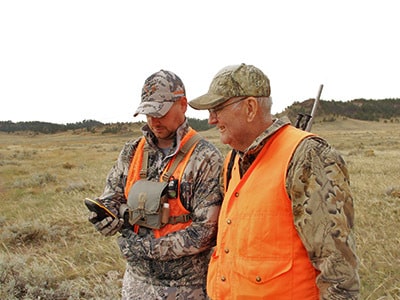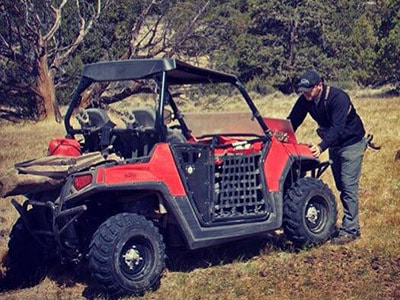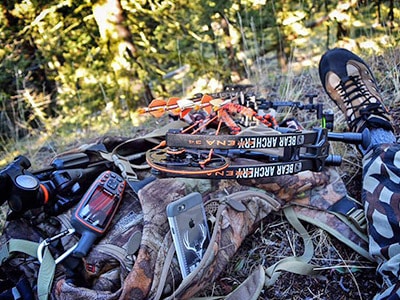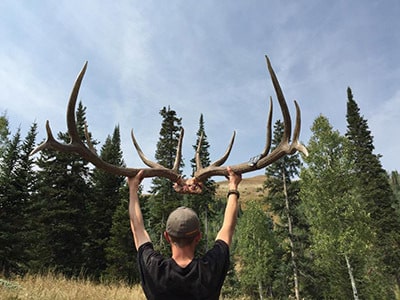1. Have a Hunting Plan
Planning your hunt can save time and confusion once you get your boots on the ground. Ask yourself several questions:
- What are the regulations in your hunting district and where are the boundaries?
- How do you plan on hunting the area?
- How do you navigate the terrain/topography?
- If someone is coming with you, how will you hunt it together?
- What is the weather forecast for the area you are traveling to?
Thinking your plan through, step by step, can help you put the pieces together. The Hunt App can be a valuable tool when planning your hunt, allowing you to visualize your hunting area and its characteristics well before the hunt.
2. Hunt With a Partner or Tell Someone Your Plans

Having a hunting partner has many benefits. With the right person, you double your chances of finding game and halve the weight you have to carry if you tag out. They can also carry you out, or get help, if you roll your ankle or worse. Although hunting with a partner is undoubtedly safer, many choose to experience the solitude of nature on their own. In this case, notify a close friend or loved one of your hunting location and the time frame you plan to be gone. It is always a good practice to let them know how long they should wait for you to return before they should be concerned. Sharing Waypoints can greatly reduce confusion if search and rescue have to come find you.
3. Check Your Equipment
Picture this: you head out deep into the backcountry and realize your portable camp stove ran out of fuel. Or perhaps you are out for the day and dusk hits; it’s time to walk to the truck and your headlamp batteries are dead. These are just some of the situations that can be prevented with a proper equipment inventory. Make sure all the gear you bring has a purpose and is ready for use. Test your gear in the off-season, break in those new boots, and make sure you know how to set up that new tent. You don’t want to be dealing with malfunctioning gear or trying to figure out how to use your equipment on the hunt.
4. Prepare Your Vehicle
Along with checking your hunting equipment comes checking your vehicle. Nobody wants to get stranded in the woods when it could have been easily prevented. Getting all standard maintenance done before the season could save you a walk. Also, make sure you have all the necessary gear in case you have car issues. Depending on how far you are going into the backcountry your gear list could be quite extensive. From a basic tire changing kit and tow strap to spare gas and a winch, be prepared for what you are getting yourself into. Always assess your drive into your hunting spot and plan accordingly.

5. Bring Proper Clothing
Always dress for the occasion. Take into account the time of year and type of terrain you will be entering and be prepared. Having moisture-wicking base layers and suitable outer layers can make your trip comfortable and safe. Bringing a spare set of base layers and socks is good practice and can be a savior if you become cold or wet. Remember, cotton kills, and should be left at home. You get what you pay for: Having a few articles of quality clothing can make all the difference when you are on an extended stay in the woods. You don’t want to spend your hunt being too hot or cold. Your focus is hunting; bringing the right clothing can make that happen.
6. Have the Essentials
You should always bring a few core essentials on your hunt. Bring a complete first aid kit equipped with a firestarter. Some people complain about added weight with a full first aid kit but its weight that could save you in a bind. Having a knife is essential for your hunt and can be handy in many situations. Also, be sure to bring spare food and water. Including iodine tablets in your first aid kit is a good practice. Packing a few high-calorie bars or comparable food will help give you that extra get-up when you need it. Preseason planning and prepping will allow you to know what essentials you currently have and what you will need before the season kicks off.

7. Bring a Paper Map and GPS
Being a map company, we know the value of a good map. Having a handheld GPS or the Hunt App is a luxury that can save you space and time when you’re looking for the closest draw or next peak. The ability to navigate with ease and understand your surroundings can make your hunt more effective and organized. Downloading the Hunt App will give you the most up-to-date and relevant map data on the market. Always charge your phone before you head out, and consider investing in portable power banks. It is also good practice to bring a paper map of the area you will be in, along with a compass, just in case.
8. Know Your Weapon: Practice, Practice, Practice
There is a big difference between owning a weapon and knowing how to use a weapon. Making sure that your weapon is sighted in and you are capable of accurately shooting your weapon are key components of a successful and safe hunt. You should practice shooting your weapon from many stances and distances to prepare for the field. Take it out on pre-season hikes to know how it carries. Finding a comfortable sling can make carrying your weapon more bearable on long hikes. Know your weapon inside and out before you start chasing game.
Once you are on your hunt, weapons safety is a must. Treat your weapon as if it were loaded at all times and practice muzzle awareness from the moment you pick it up. Be a safe hunter; never point your weapon at other people and don’t use your rifle scope to glass for animals in the field. It is good practice to bring binoculars for glassing to minimize the risk of pointing your weapon at unsuspecting passersby.
9. Stay Focused
It is easy to lose focus when on the chase. Buck or bull fever can set in and it’s easy to forget about your surroundings. As a hunting safety tip, be aware of your hunting partners’ locations to minimize the risk of tagging them instead of your animal. Most hunting success occurs when a hunter is in tune with the environment and focused on every little detail. Hunters can get tunnel vision and become focused only on that bugle they heard in the distance or buck they see on the ridgeline. This can result in poor decision-making and dangerous situations. We all want to fill that tag but take a moment and think as the thrill of the chase sets in.

10. Be Aware
Being aware is an all-encompassing term that comes into play in all aspects of your hunt. Be aware of your needs and safety precautions. Awareness of your own physical shape and the terrain you will be entering is crucial. How far will you be from help? What kind of animals call this area home? How many of those animals are dangerous? How capable are your hunting partners?
Take some time before your hunt and do your research. Know the area, know your abilities, and know what gear you will need to make your hunt safe, and if you’re lucky, successful.